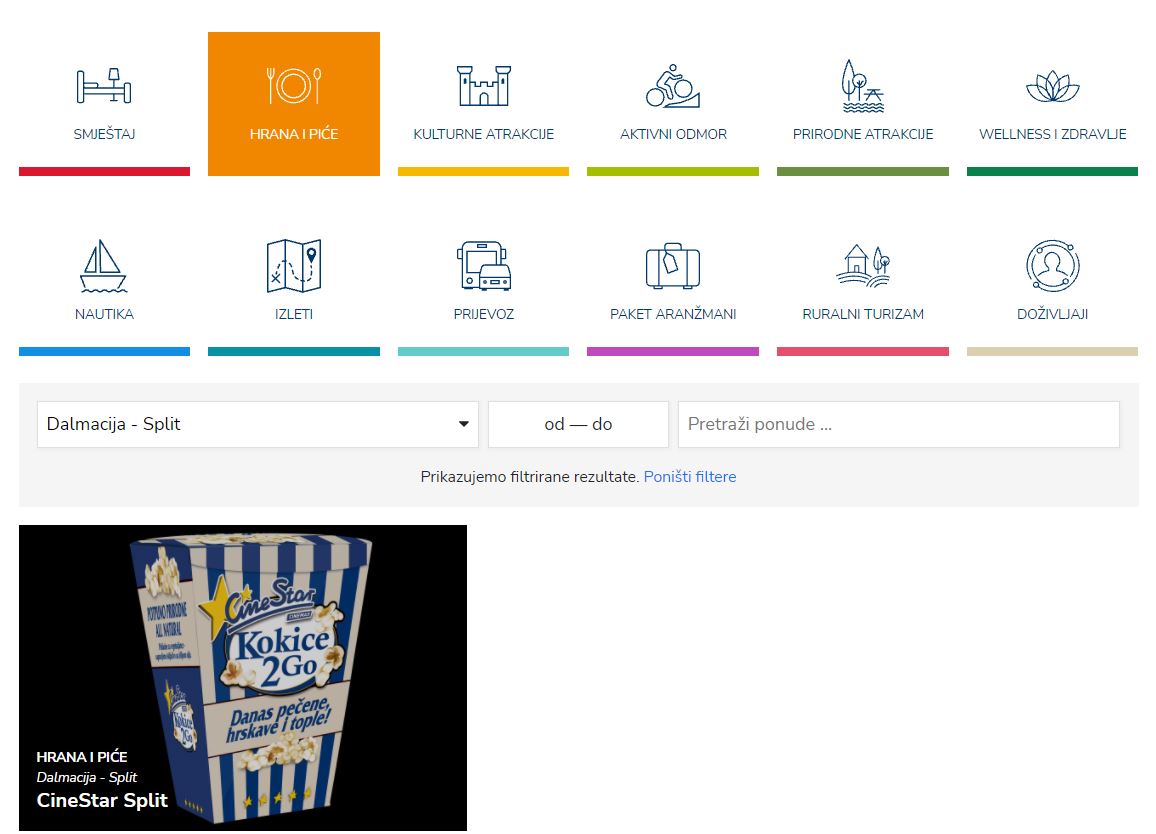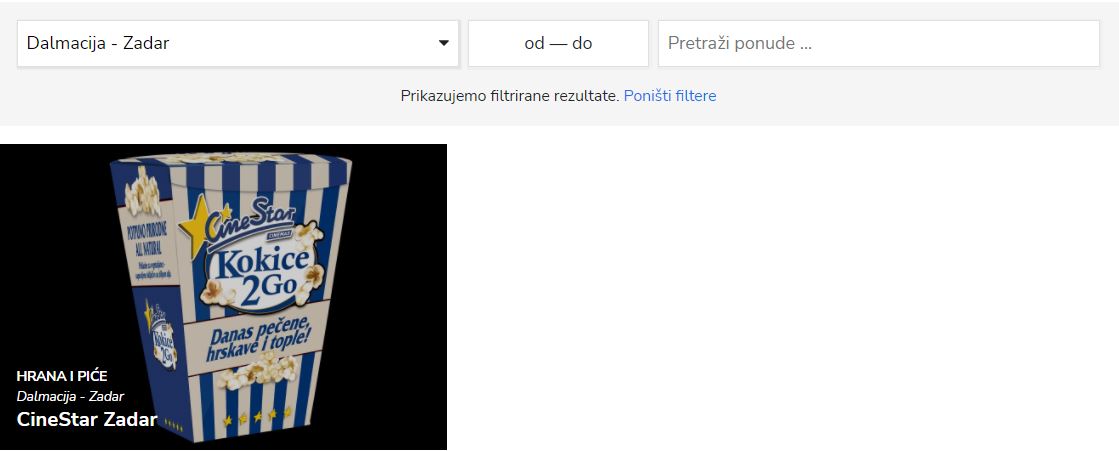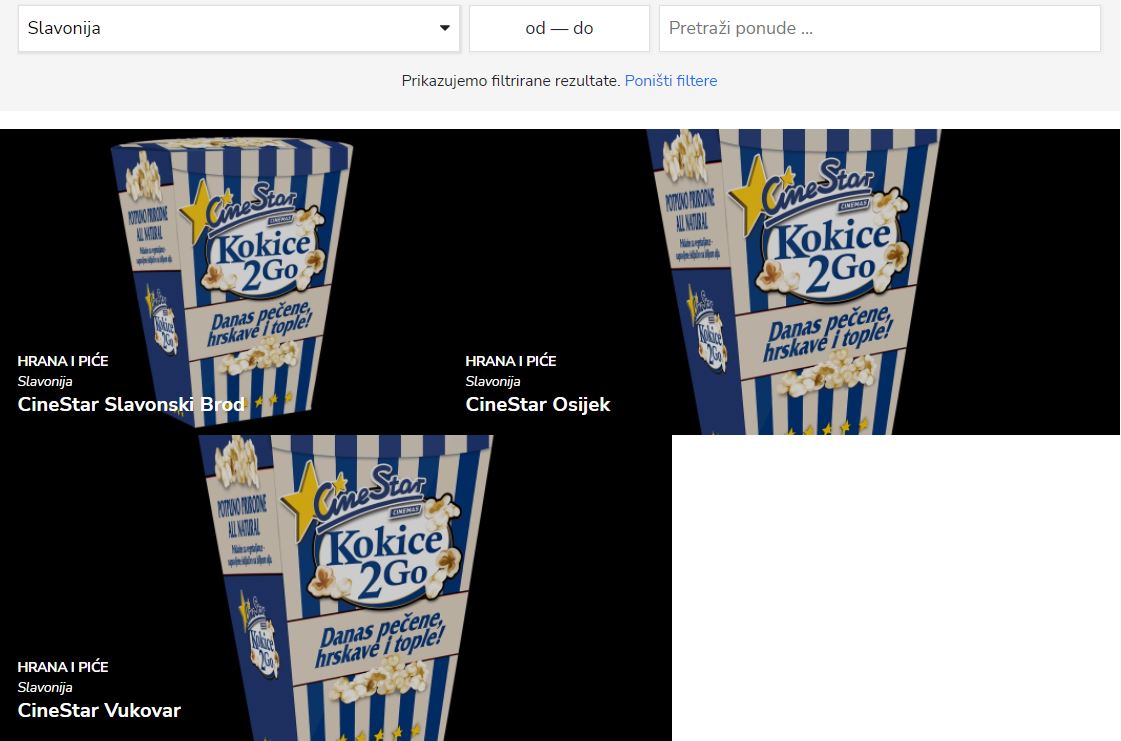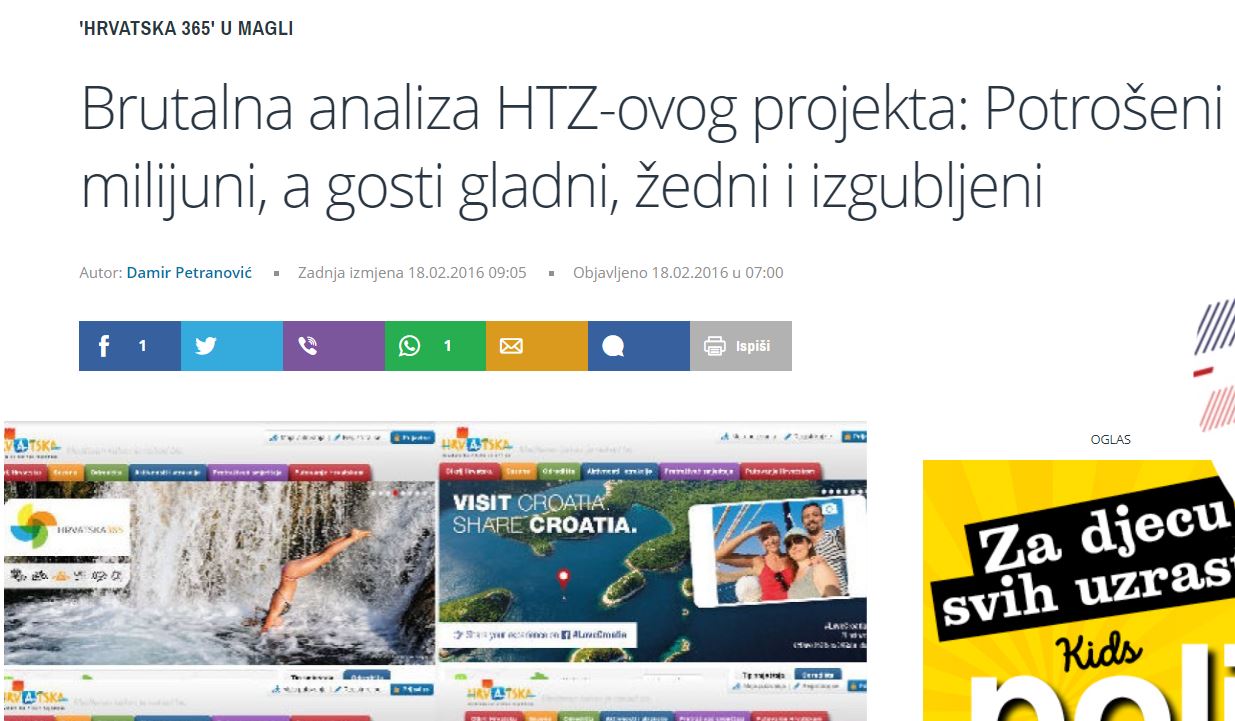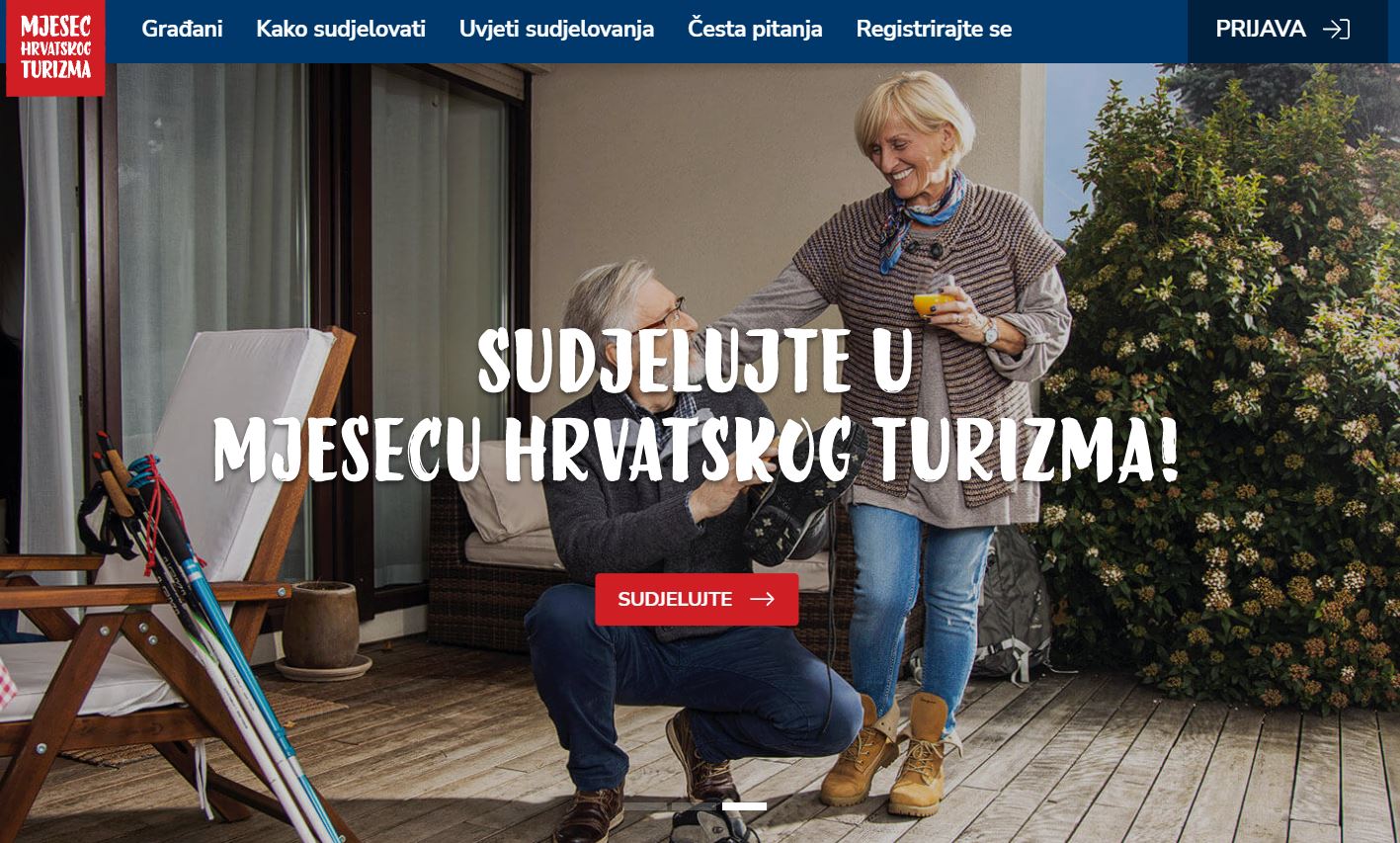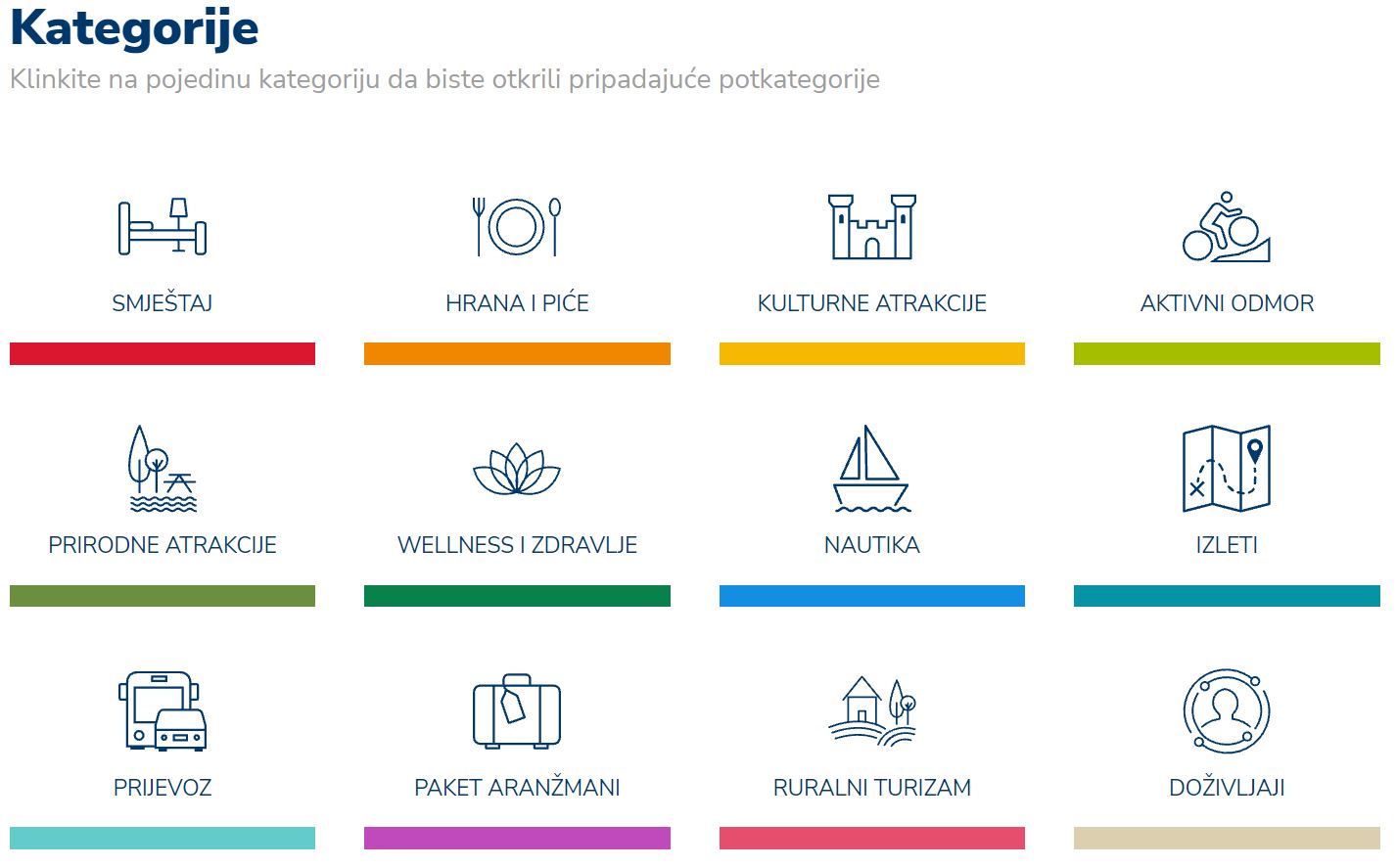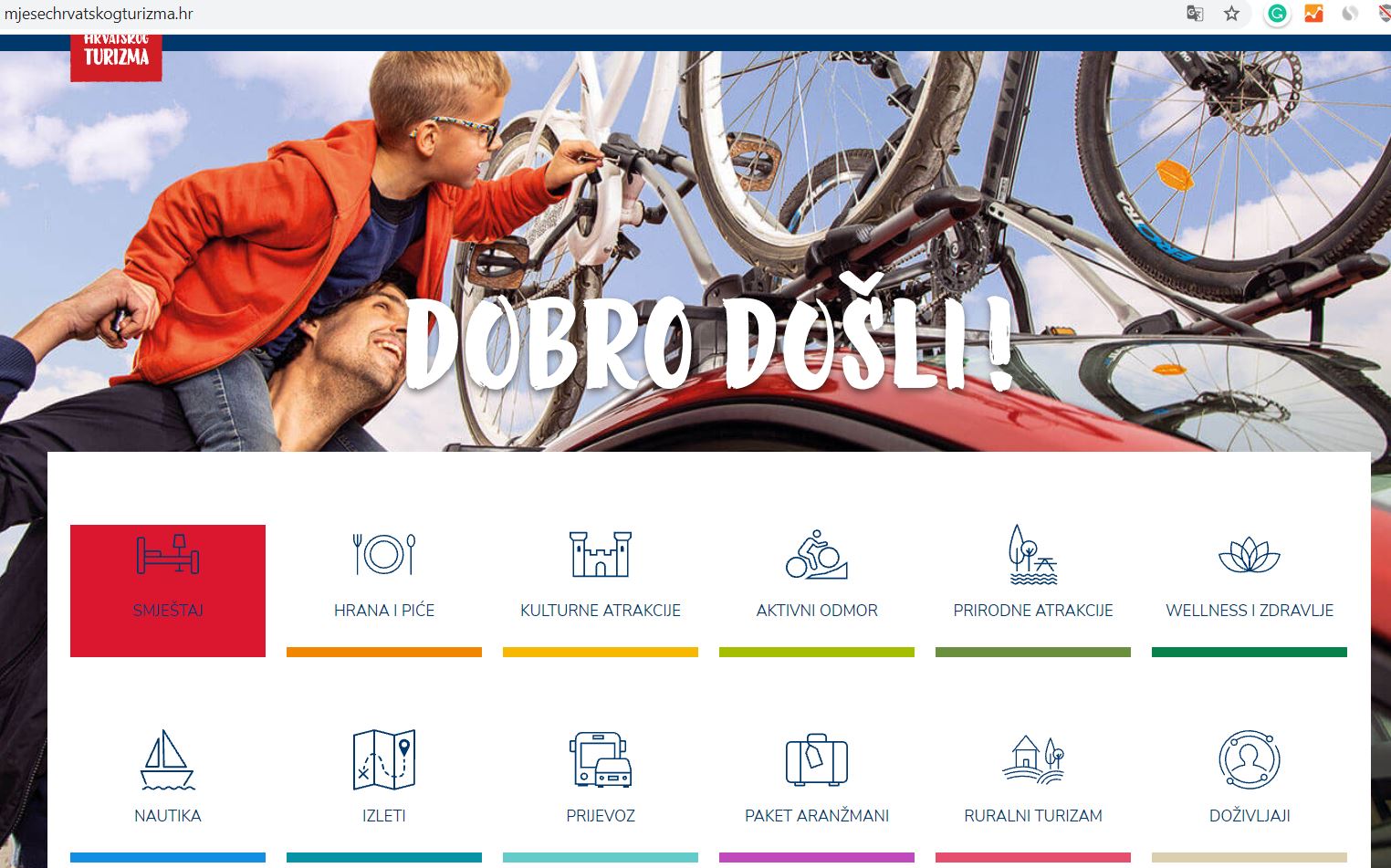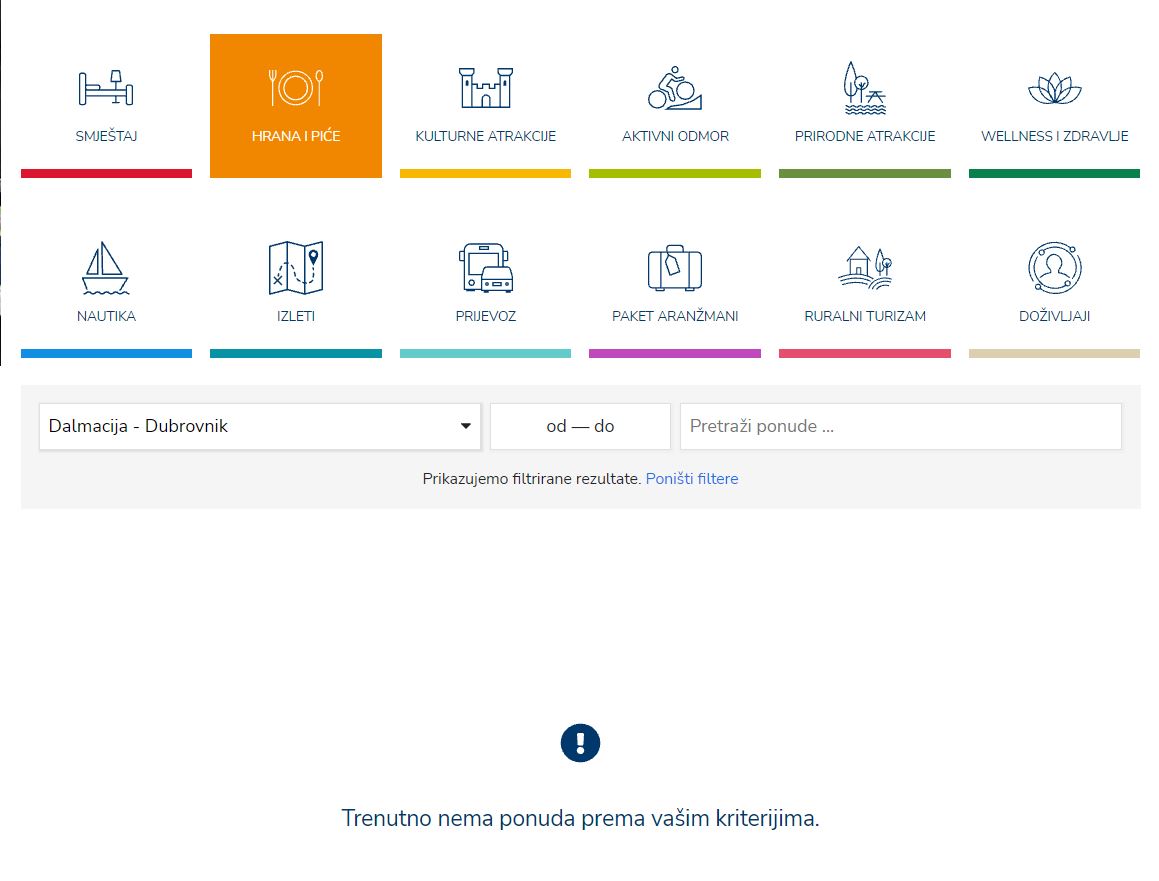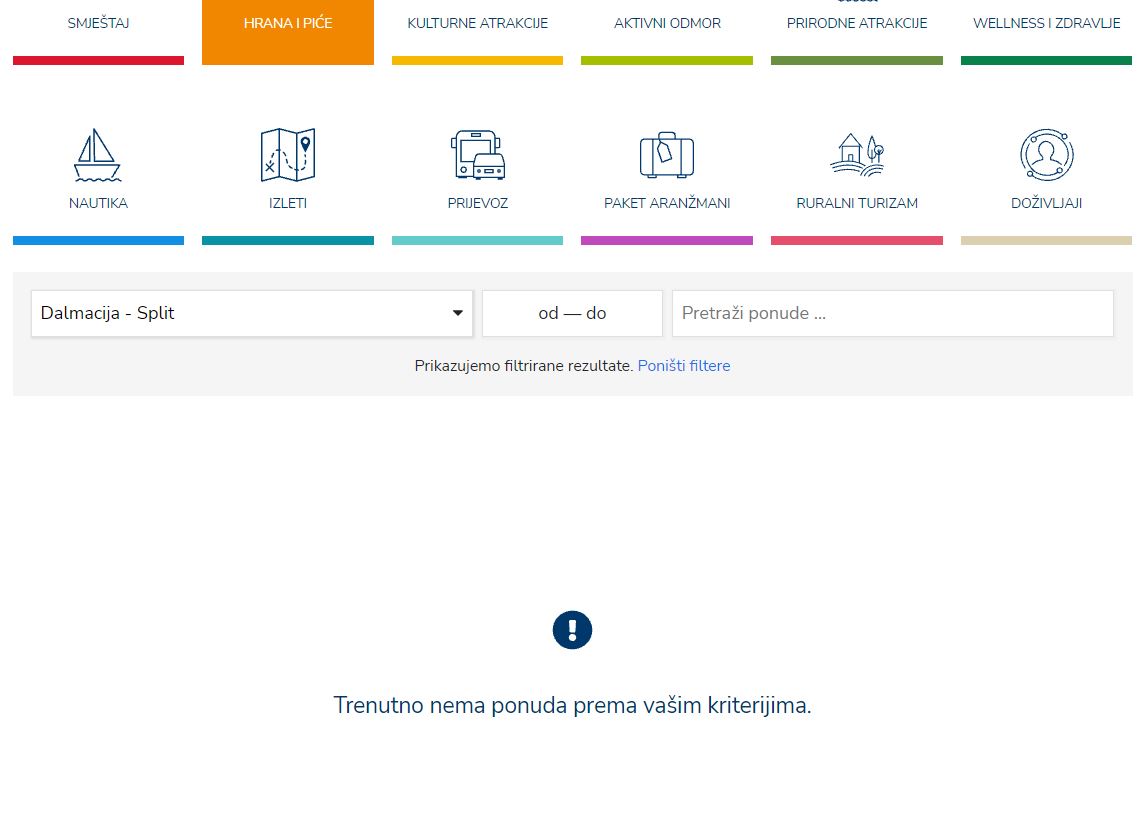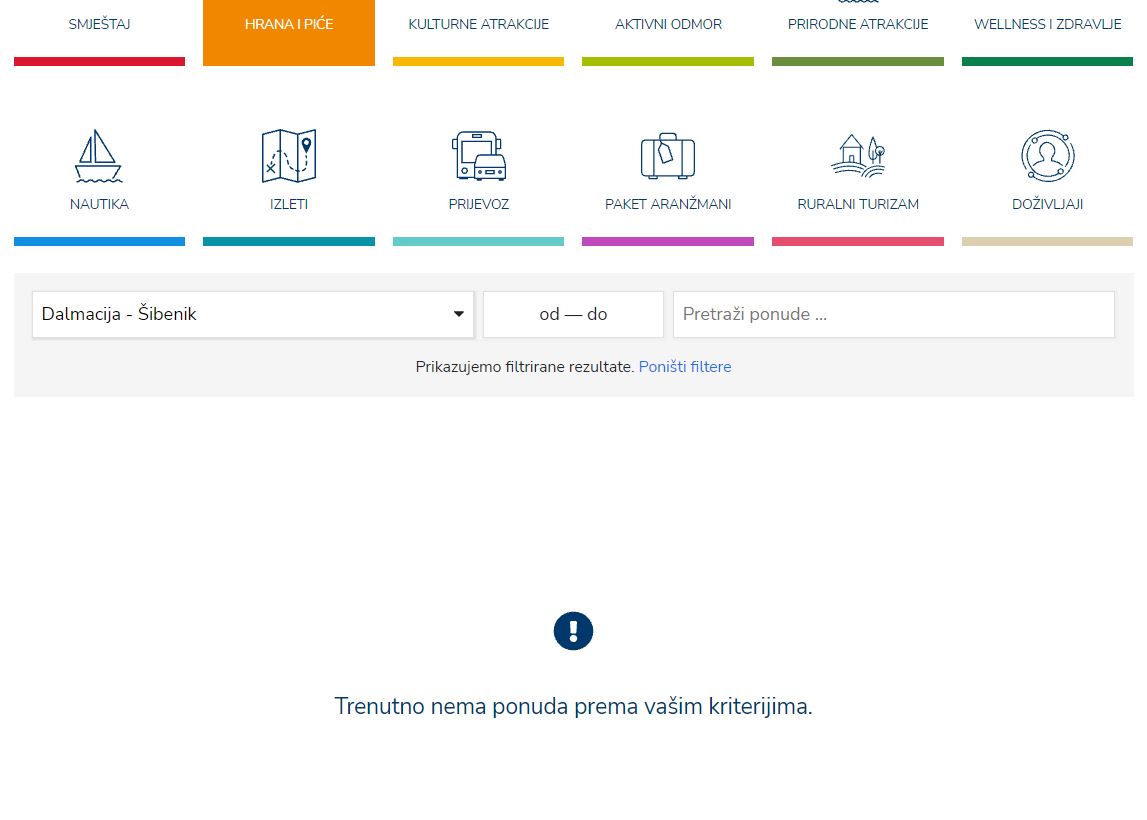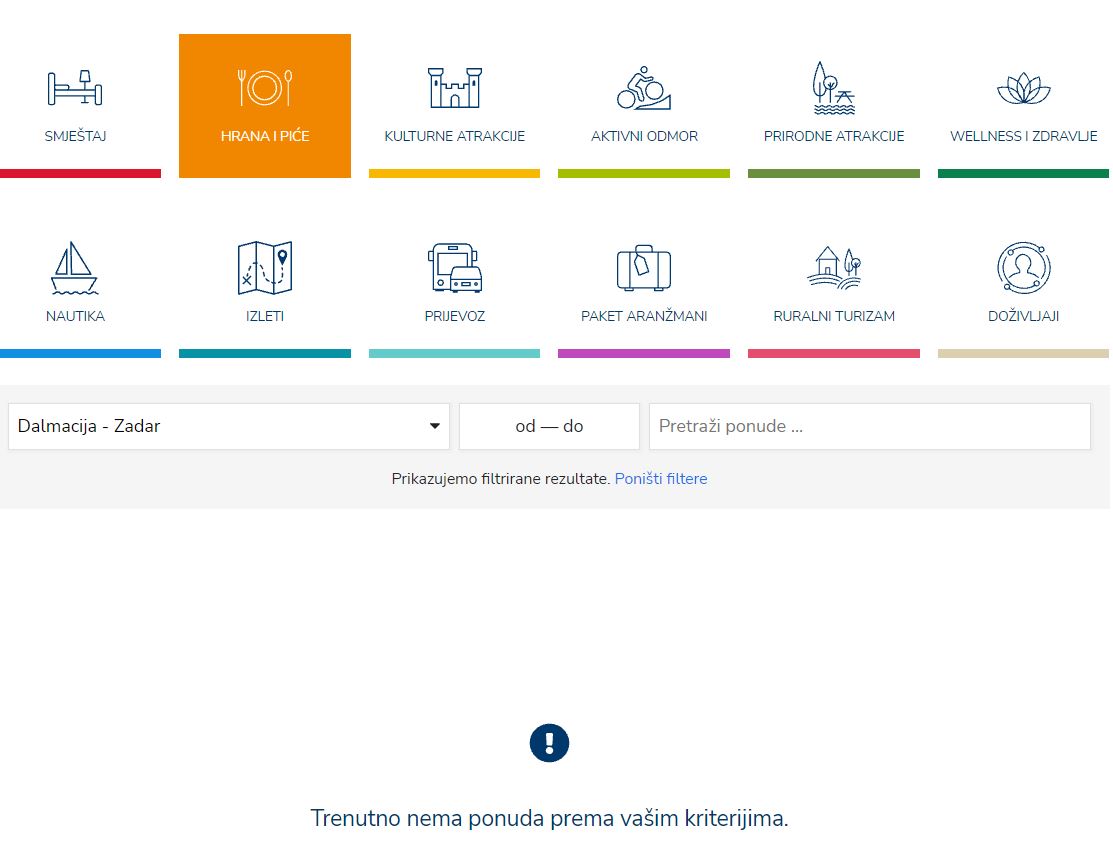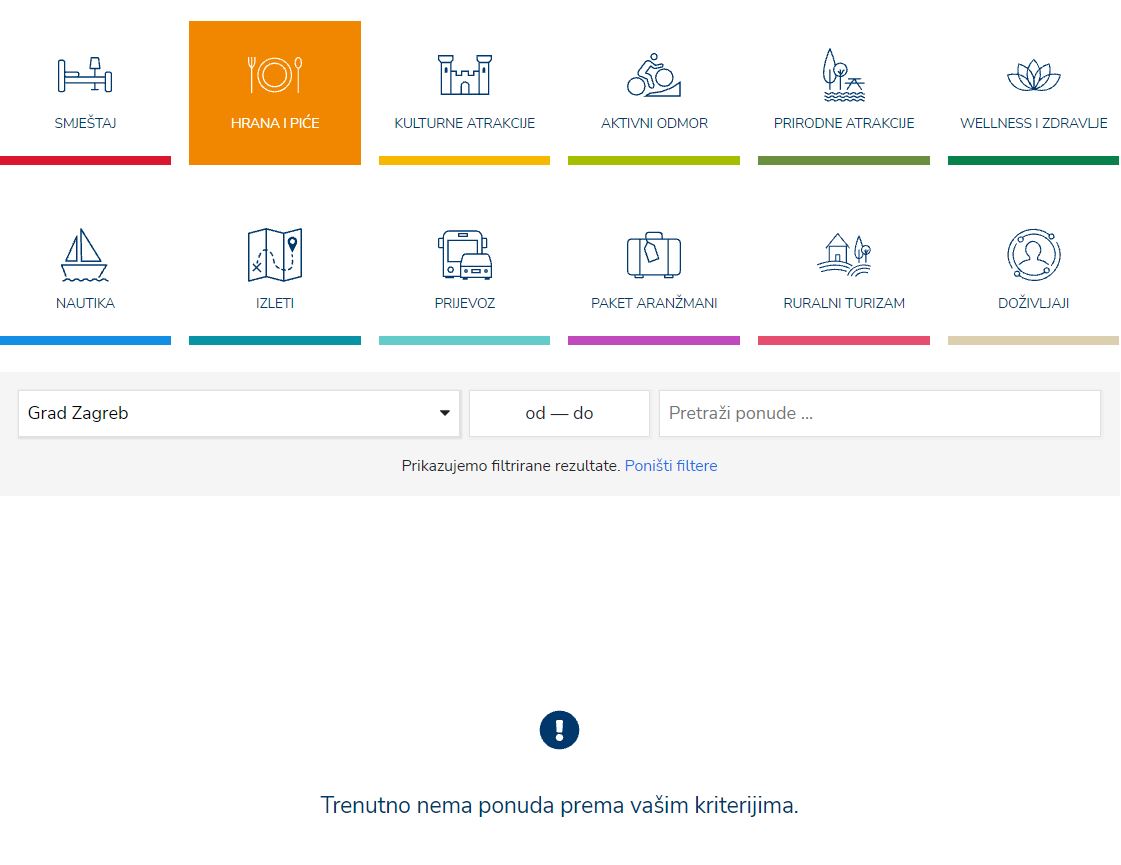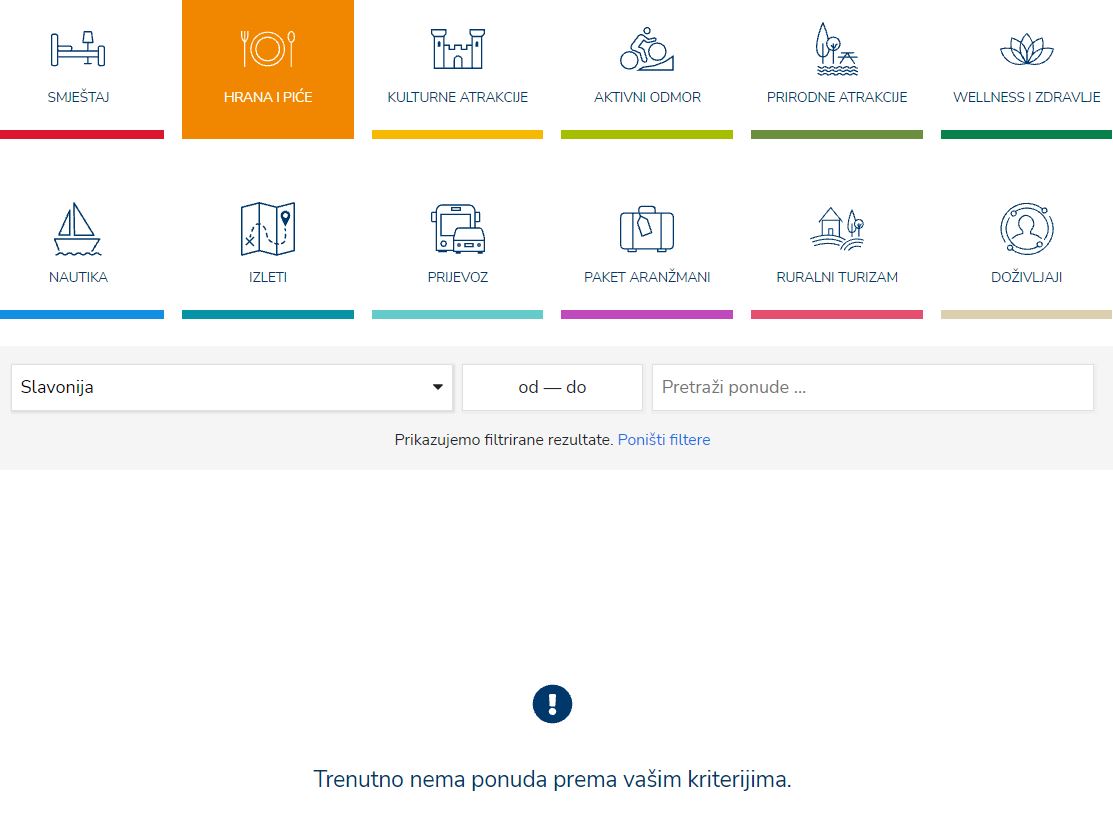Gourmet Croatia: 35% Off Popcorn the Only Offer in Kingdom of Accidental Tourism
October 31, 2021 - We are 3 weeks into Croatian Tourism Month, a shiny promotion to extend the season in the Kingdom of Accidental Tourism. Anyone hungry? We have 35% off popcorn at the cinema in Central Dalmatia, Slavonia, Zadar County. And nothing else.
There was a typically upbeat press release from the Croatian National Tourist Board on September 30, announcing something called Croatian Tourism Month. This is how it began:
The “Croatian Tourism Month” campaign starts tomorrow, a project of the Ministry of Tourism and Sports and the Croatian National Tourist Board, within which numerous tourist services and experiences will be available at 35 percent more favorable prices. Thus, all Croatian citizens, as well as foreign guests who will be staying in Croatia during October, will be able to tourist services in all parts of Croatia at attractive prices, and everything will be available on the “Croatian Tourism Month” portal.
And this is how it ended:
The project "Croatian Tourism Month" is a continuation of last year's extremely successful project “Vacation-Worthy Week” which was implemented in the period from October 16th to 25th, and which this year, due to the great interest of tourism entities and the public, will run throughout October. Let us add that the main goal of the project is to extend the tourist season by encouraging domestic and foreign tourist traffic in the post-season.
It sounded like a great idea, especially if it was building on the apparent success of last year.
It is a great idea.
But ideas and execution are two very different things, especially in this kingdom. As we explored in 'Croatian Tourism Month' Campaign: Hype and the Sad Reality' recently, it was something of a surprise that the press release claiming to be targeting foreign tourists, as well as domestic, was only in the Croatian language. But that was only the start of the story - a quite extraordinary journey ensued.
Croatian Tourism Month hosted the excellent Taste the Mediterranean festival in Split from October 6-9, just one of many gourmet events going on in the Dalmatian capital. I was curious what culinary beauties might be on offer in Central Dalmatia by way of comparison in this official promotion to extend the season.
The answer? In the whole of Central Dalmatia, a region famed for its outstanding authentic cuisine, the only thing on offer in Central Dalmatia was popcorn at Cinestar in Split. With a 35% discount.
Zadar County had the same story, just the popcorn option in the city of Zadar.
Mighty Slavonia (at least that is what the regions of eastern Croatia are referred to on the official website) fared somewhat better, with no less than 3 popcorn options.
Is is a decade since Anthony Bourdain told the world about Croatia's world-class food, world-class wine, and world-class cheese. It is just a few weeks since Gordon Ramsay's enthusiasm for Croatia cuisine was seen by millions around the globe.
And yet, what do we have to offer - konkeretno - for those tourists who love the idea of October travel and a Croatian gourmet exprience?
Here is a translation of the entire offer for Central Dalmatia:
CineStar Split
In the period from 14 to 30 October 2021, as part of the Croatian Tourism Month campaign, Blitz-CineStar will offer all visitors a discount on salty popcorn TO GO, 35% discount, in all branches throughout Croatia in the food and beverage segment.
The regular price of KOKICA TO GO is 32,00kn, the price with a 35% discount is 20,50kn.
The discount will be valid for the entire duration of the promotion and will be valid for all dates and cinema days.
A reminder again of the last paragraph of the official press release - due to the great interest of tourism entities.
There are a total of 27 entries in the food and drink offer on the Croatian-language only Croatian Tourism Month website for the whole of Croatia, a country famed for its gastronomy. Of these, 11 are CineStar offering popcorn discounts, leaving just 16 establishments offering food or drink. This in the second year of an initiative, which has been expanded due to last year's success, according to the official press release.
If this is success, how do we define failure?
Did you know that before the Kings of Accidental Tourism took over the running of tourism in Croatia, that winter tourism was a big thing? Fascinating interview with a UK tour rep who was based in former Yugoslavia from 1986 - 1991. Croatian Winter Tourism in 1990: Full of Life! Tour Rep Interview.
Imotski Apartments Prove Hit, Reservations for Next Summer Already Coming
October the 19th, 2021 - When most of us who live in Croatia think of Imotski, we tend not to think of tourism and foreign tourists arriving en masse. The image of this inland Dalmatian destination, however, is gradually altering as foreign visitors discover the hinterland and all of its wonder a stone's throw away from the coast. Imotski apartments have done exceptionally well, prices have increased and reservations for summer 2022 are already coming in.
As Poslovni Dnevnik writes, yet another tourist season marked by the coronavirus pandemic has passed us by, and for the Imotski region it was especially lucrative, because their 2.5 thousand beds were more or less all filled.
Namely, after a successful tourist season, most of the 384 owners of luxury holiday homes with swimming pools in Imotski are satisfied. Imotski will, this year for the first time in history, record as many as 100 thousand overnight stays, four thousand more than back in pre-pandemic in 2019 when staying in private Imotski apartments with pools and amazing views was nowhere near as popular as simply heading straight for the coast.
"We had a great peak of the season and we also did well in September, but the pre-season was a non-starter and that's why we're still behind that year. This year in the Dalmatian hinterland was marked mainly by guests from Germany, Poland, Scandinavia, the Netherlands and Austria.
Reservations came in at the last minute, and 2022 already shows that it will be different and the competition will end up being much stronger. That's why marketing will be very important to us, which will be done during the winter, because the market needs to be reached with quality messages,'' said Ana Marija Paleka, head of the Novasol office for Slobodna Dalmacija.
Everyone involved in the home and private apartment rental business agrees that there has been a lot of thoughts being put into and around pricing formation this year, so some have significantly lowered their prices in fear of vacant properties, while others have increased them significantly as demand has visibly and in some cases quite rapidly grown.
"All this is logical because we went through the night from despair to euphoria, or from 50 euros to 300 euros per night in the same building. No one expected such interest at once and not everyone coped equally in it. It's really important that we keep the quality up. People should be prudent and careful in thinking about business for 2022, because there can be surprises. We're entering a normal year with strong competition and not everything will be like this year was,'' warned Boris Zgomba, President of the Association of Agencies at the Croatian Chamber of Commerce (HGK).
For more, make sure to follow our dedicated travel section.
Croatian Tourism Association Expects Even Better 2022 Summer in Croatia
October 13, 2021 - Preparations are underway for the 2022 summer in Croatia after the 2021 season exceeded all expectations.
After the main tourist season and post-season results exceeded expectations, the Croatian Tourism Association (HUT) expects an even more successful tourist season next year, and preparations have already begun. The main goal is to provide enough workforce reports HRTurizam.
Namely, 4.1 million tourists visited Croatia in August, realizing 26.2 million overnight stays, the Central Bureau of Statistics announced after all the received data were collected and processed. Arrivals represent a growth of 65 percent compared to 2020, while according to the number of overnight stays, Croatia is up 57 percent compared to August 2020. Compared to the record 2019, we reached 86.3 percent of all arrivals and 94.3 percent of all overnight stays.
"This year we have shown that we are an extremely desirable and quality tourist destination and we expect that the next season will be even more successful. To achieve this, it is crucial to start preparations immediately. We expect continued investment and quality improvement throughout the sector," emphasized Veljko Ostojić, the Croatian Tourism Association director.
Most of the tourists who visited Croatia in August were foreigners (3.7 million) and accounted for 91 percent of all overnight stays and 84.5 percent of all arrivals. Among them, most guests came from Germany and accounted for 35.7 percent of all foreign overnight stays or 8.6 million, an increase of 72.2 percent compared to August 2020, and 88.7 percent more or 1.1 million. On the other hand, compared to August 2019, there were 43.4 percent more Germans in Croatia, with 39.5 percent more overnight stays. After the Germans, the Poles are in second place in terms of overnight stays, followed by the Austrians, Slovenes, Czechs, Dutch, and Italians.
In September, 1.9 million tourists visited Croatia and are responsible for 12 million overnight stays, which is a plus of 245, or 147 percent compared to last September, but also 81 percent of tourist arrivals and 94 percent of overnight stays from September 2019.
With superior numbers of arrivals in the peak season, tourists stayed in Croatia longer this year and spent more, even compared to the record year 2019, which was especially emphasized in August.
According to the analysis of the Tax Administration and data in 2019, 2020, and 2021, the fiscalization system shows an increase in consumption, i.e., an increase in the number and amount of invoices in the hospitality industry compared to last year.
The results once again showed the importance of tourism in the overall Croatian economy, with a share of more than 20% of GDP, which generates a third of Croatian exports and employs about 100,000 people.
"Good management of human resources in tourism, primarily by investing in their knowledge and skills, we will raise the quality that has proven to be the key to success in the pandemic years. Continuously raising quality will enable greater competitiveness, which is the formula for success in the coming years. For this reason, we began to work on preparations for next summer actively and sent to the ministries our proposals for measures to preserve and improve the labor market in the tourism sector. It is necessary to start implementing the measures now, to keep quality people and attract new staff," concluded Ostojić.
For more on travel in Croatia, follow TCN's dedicated page.
Historic Chance to Abandon Old Croatian Mass Tourism Model
October the 12th, 2021 - The Croatian mass tourism model (if you can even call it a model) could finally be sent to the history books as the country has a historic chance before it to bin this method and become more sustainable than simply counting the number of arrivals.
As Poslovni Dnevnik/Marija Crnjak writes, no matter how successful they considered this tourist season to be due to the sheer volume of overnight stays and income, it was incidental. Many things which occur in Croatia end up being totally accidental, and this season we had a favourable epidemiological picture to thank more than pretty much anything else. While this summer was fantastic for the domestic economy, finally pumping what it desperately needed back into it after a lean 2020, we actually ended up with what we were declaratively running away from, Croatian mass tourism, which is far from sustainable.
Therefore, in 2022, but also every following year, Croatian tourism should build itself on everything that has been learned throughout the coronavirus pandemic, and that is that guests are looking for quality, premium product and are willing to pay more for it, and that the primary interest is sustainability. Getting excited over rising numbers on the eVisitor system is dying of death, and Croatian mass tourism has done far more harm than good if one dares to glance outside of the state budget's purse strings.
More cooperation in the EU
In addition to the above, this country's tourism sector needs to communicate more and set some proper models for building common strategies, and the European Union and its member states all need to work more together to maximise passenger mobility and strengthen people's confidence in travel safety following this unprecedented public health crisis in which faith in airlines and travel companies was lost.
Some of this was pointed out by the participants in the conference on year-round tourism "Tourism 365" held on Friday in Tuheljske toplice in continental Croatia, with the participation of various ministers and state secretaries in charge of the tourism sector from four European Union countries, and the Prime Ministers of Croatia and Slovenia Andrej Plenkovic and Janez Jansa.
"Our goal is not to stick to counting tourists and arrivals and thinking about how to break records. The goal is sustainable tourism, to have a distributed number of tourists throughout the year. Therefore, the Month of Croatian Tourism project, which is ongoing, is also important to us,'' Croatian Tourism Minister Nikola Brnjac stated.
Slovenian Minister of Economy and Technology Development Zdravko Pocivalsek pointed out that even before the coronavirus crisis, Slovenia had begun developing its own model for sustainable tourism, and during the pandemic, they invested more than a billion euros in aid to the tourism sector, including vouchers for residents of Slovenia, which strengthened domestic tourism.
Fernando Valdes Verelst, Spanish Secretary of State for Tourism, stressed the importance of strengthening co-operation between EU countries in the future, in order to stabilise tourist flows.
"There was cooperation this year as well, but it could have been stronger. We also need cooperation in terms of marketing, and the stronger advertising of Europe as a destination towards distant markets, whose opening is expected,'' said Verelst. The extention of the tourist season is part of the policy of sustainable tourism, and in the pandemic, Croatia got a historic chance to develop a sustainable product,'' said Ivana Budin Arhanic from Valamar, adding that this year tourists showed great interest in quality and premium products.
Kristian Sustar from the Uniline agency warned that we shouldn't brag too much about this year's season, so that it doesn't somehow end up becoming an example of good practice. "We had a fantastic result, but it must be seen for what it was, incidental. In reality, we had three months of work and Croatian mass tourism, and that isn't what we say we want,'' concluded Sustar.
For more on sustainable tourism, check out our travel section.
German TikToker Jackthebackpacker Complains About Croatian Coast
October the 11th, 2021 - German TikToker Jackthebackpacker has publicly complained about the Croatian coast, more precisely Dubrovnik and some of the prices and services there.
If there is one complaint that the Croatian coast gets each and every summer (one of the very few), it's that things are too expensive. While those of us who live here often disagree, because you quite simply need to find the more local and out of the way places and not expect a coffee on the UNESCO protected Stradun to be cheap, the comments keep on coming. The issue of parking continues to be a big one, and most people would agree it's problematic in most coastal cities.
As Poslovni Dnevnik writes, German TikToker Jackthebackpacker, who is otherwise from Berlin, recently arrived in Croatia, more precisely Dubrovnik, but he is not as enthusiastic as many other tourists are about Croatia's stunning southernmost city. He recorded a video and explained what disappointed him about Croatia's tourist Mecca.
Right at the beginning, he pointed out that he thinks this is one of those cities that just wants to get the last coin out of the pockets of tourists and not much else.
"An hour of parking is 5.5 euros, but well, they are kind, so they give you 24 hours for only 65 euros," he said ironically, adding that insanely high prices continue in other services, especially in restaurants and cafes, according to a report on the topic from Vecernji list.
“A portion of french fries is 5.5 euros, a hamburger costs 11 euros, which isn't so terrible, but then again... some coke costs 5.3 euros? What robbery,'' stated German TikToker Jackthebackpacker.
He also complained about the crowds in the city, which are unbearable and which make it impossible to visit everything you want to see.
“This is another big scam - if you want to walk along those famous walls, you have to pay as much as 26 euros! They also have a selfie museum where you can take pictures… Who would even want that?!''
In the end, he said that he what he did like was the prices of fast food restaurants and supermarkets because they are the only places with down to Earth prices - he paid three euros for a sandwich.
“I don’t want to be too negative, there are nice things here, but there are also better destinations. It's insanely expensive!'' concluded Jackthebackpacker.
For more, make sure to check out our lifestyle section.
Croatia Makes Condé Nast Traveler's 2021 Top 20 Countries in the World
October 6, 2021 - After being snubbed by The Guardian as one of the 10 of the best half-term holidays in Europe, Croatia's loyal American tourists came through once again, as the country found its place on Condé Nast Traveler's 2021 Top 20 Countries in the World.
Croatia is recognized as one of the world's top destinations, taking an excellent 9th place on the list of 20 best destinations chosen by readers of the popular American travel magazine Condé Nast Traveler. The list is part of the prestigious Condé Nast Traveler's 2021 Readers' Choice Award, reports HRTurizam.
The list is led by Portugal, New Zealand, Japan, Morocco, Sri Lanka, Italy, Iceland, and Greece, followed by Croatia and Turkey, Norway, Maldives, Kenya, Ireland, Israel, Australia, Switzerland, Indonesia, Botswana, and the Philippines.
"We are extremely pleased to hear that the readers of Condé Nast Traveler have recognized Croatia as one of the most popular countries in the world. This is a confirmation of the exceptional reputation of our country among American travel enthusiasts who perceive Croatia as a quality, attractive and safe destination," said Ina Rodin, director of the Croatian National Tourist Board Representation in the US, adding that this recognition is a great motivation to further position Croatia as one of the most popular destinations for Americans.
Let’s add that the Readers ’Choice Awards represent the longest-running and most prestigious recognition of excellence in the travel industry and are awarded based on the votes of more than 800,000 Condé Nast Traveler readers who submitted responses and ratings based on experience gained while traveling around the world.
So far this year, U.S. travelers have recorded a growth of 454 percent in arrivals and 304 percent in overnight stays over the same period last year.
It was recently officially announced that visas would no longer be needed for Croatians to travel to the USA, which was welcomed with open arms. However, the United States CDC announced on October 4 that they do not recommend traveling to Croatia. If this will slow down the arrival of American tourists, it is challenging to say, but if we take the European ECDC, for example, it will have little or no effect.
For more on travel in Croatia, follow TCN's dedicated page.
'Croatian Tourism Month' Campaign: Hype and the Sad Reality
October 5, 2021 - The Croatian National Tourist Board announced October to be Croatian Tourism Month in a press release last week. A quick look at what could have been a great initiative shows all is not as it seems.
Let me start by saying I think it is a great idea.
Lots of things start as great ideas with official Croatian tourism promotion.
And with a nice press release and media PR campaign, all is well with the world.
As long as nobody actually looks at the detail...
The plan - to help extend the season by offering 35% discounts to domestic and foreign tourists for the month of October - makes a lot of sense. If Croatia is to extend its season, October is perhaps the easiest month to do so.
And there is certainly demand, if you follow the UK media, for example - Half-term holiday bookings jump 200% after England travel rules change.
So much so in fact that The Guardian dedicated a feature story to it a few days ago - 10 of the best half-term holidays in Europe – from Alpine cycling to sunbaked Rhodes.
You would expect Croatia to be on that list, surely? Sadly not.
Autumnal Lake Bled, the Eastern Algarve, Rural Romania, and Hassle-free Rhodes all made the list but nothing that Croatia could offer. And yet, at the same time, a shiny new website and promotion for Croatian Tourism Month, the month of October. Curious, I decided to check out the website and see what magic one could enjoy.
I genuinely wish I hadn't.
The last time I looked into a website of a much-hyped official Croatian tourism project was over 5 years ago, and the now infamous Croatia365 project. Little did I know that my Sunday afternoon musings over a couple of beers would turn into the top story in the Croatian media the following day, and lead to my first and only meeting with a director of the Croatian National Tourist Board. The original article is still live on TCN.
A lot can happen in 5 years, and I decided to give the press release my full attention. A solid start:
The “Croatian Tourism Month” campaign starts tomorrow, a project of the Ministry of Tourism and Sports and the Croatian National Tourist Board, within which numerous tourist services and experiences will be available at 35 percent more favorable prices. Thus, all Croatian citizens, as well as foreign guests who will be staying in Croatia during October, will be able to tourist services in all parts of Croatia at attractive prices, and everything will be available on the “Croatian Tourism Month” portal.
And a promising finish:
The project "Croatian Tourism Month" is a continuation of last year's extremely successful project “Vacation-Worthy Week” which was implemented in the period from October 16th to 25th, and which this year, due to the great interest of tourism entities and the public, will run throughout October. Let us add that the main goal of the project is to extend the tourist season by encouraging domestic and foreign tourist traffic in the post-season.
All sounds nice.
So I clicked on the link in the English press release (interestingly, it did not go to the home page), putting myself in the mind of a foreign tourist with no Croatian language, keen to see what Croatia has to offer in October with a 35% discount. I invite you to do the same. Let's take a tour of the magic of Croatian Tourism Month, the official website, through the eyes of an English-speaking foodie, for example.
This, remember, is a national tourism promotion project by the Croatian National Tourist Board and the Ministry of Tourism and Sports. Croatian speakers might think this landing page is ok. It is.
If you speak Croatian.
The first surprise is that the website is only in Croatian. So it seems that we are back to the old strategy of a few years ago of looking exclusively for Croatian-speaking foreign tourists. If this was a project looking exclusively for domestic tourists, then I would understand, but as CNTB explained in the press release - Let us add that the main goal of the project is to extend the tourist season by encouraging domestic and foreign tourist traffic in the post-season.
I was feeling discouraged.
Perhaps I could punch my way out of this landing page and end up somewhere more useful. Not as easy as it sounded. If I clicked on the Home icon, I stayed on the same page. There was no search button, and if I clicked on the thing called Prijava, it asked for my email address. In Croatian.
The next option was something called Sudjeljute. That leads to another registration option, again in Croatian.
I tried scrolling down, and I was rewarded with what I wrongly assumed to be progress. What looked like categories of things to do, places to stay, and where to eat. In the guise of a hungry non-Croatian speaking potential tourist, I was finally going to discover the mouthwatering Croatian gastronomic delights that so enthralled the likes of Gordan Ramsay and Anthony Bourdain.
Or so I thought.
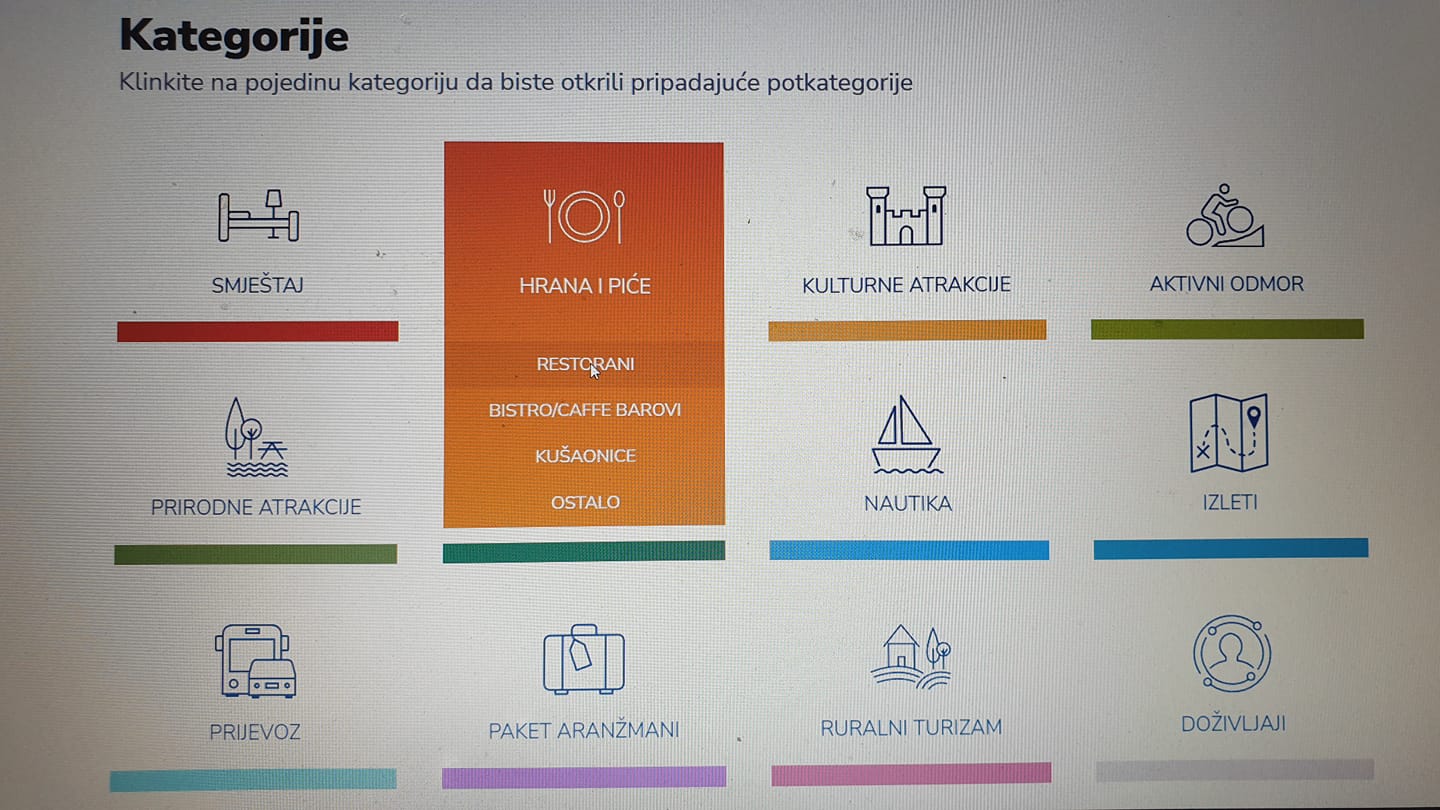
The Croatian National Tourist Board had helpfully added such useful icons for those not fluent in Croatian, and I guessed that Hrana i Pice, with its plate and cutlery was probably the food and drink section.
And so it was as I hovered over it - a sub-menu appeared. We were getting there. Restorani, bistro, caffe, barovi - we were in the right place. This Croatian language was not as hard as I thought.
None of the links in the sub-categories worked, and I was stuck on the same page. You could click on Restorani until the cows came home - but there would be no steak for you for dinner.
I was beginning to feel like a prisoner on the page the Croatian National Tourist Board press release had sent me to.
With no obvious clickable way out, I decided instead to manually type in the homepage, and here was progress indeed.
I met the same categories and there seemed to be a selection function by region or city. In my imagination, I was driving all the way from Montenegro along the Adriatic coast to Kvarner, then to Zagreb and then the wonders of Slavonia. What wonderful culinary treats would the Croatian Tourism Month promotion have in store for me, with the additional bonus of a 35% discount?
Not a lot in the Dubrovnik region, it seemed.
A four-hour drive to Split would be rewarded with an empty stomach.
Perhaps the magic of Sibenik had something to satisfy my hunger?
And not a lot in Zadar, either.
I was beginning to think that perhaps there was a bug in the website code (actually, I would probably have eaten some fried bugs by this stage), but then the welcoming site of Croatian pancakes at the National Park Risnjak, close to Istria, showed that there was at least something to eat in Croatia in October.
It was a good job that we did stop and eat at Risnjak, for there was nothing on offer in the Croatian capital, Zagreb.
And rather a shame for Slavonia that there was nothing to eat, given that the fabulous HeadOnEast starts this week. Here is what tourists could be finding out about for the month of October in Slavonia, in the video below.
With such impressive official promotion of Croatia's official efforts to extend the season, perhaps it is no wonder that The Guardian looked elsewhere for its half-term recommendations.
A little investigation came up with the sad reality that there are only NINE restaurants in the entire country currently taking part in this national campaign. And while I can sympathise with something that starts small, remember the words of the official press release (I have added the bold):
The project "Croatian Tourism Month" is a continuation of last year's extremely successful project “Vacation-Worthy Week” which was implemented in the period from October 16th to 25th, and which this year, due to the great interest of tourism entities and the public, will run throughout October.
The great interest of tourism entities for a 10-day period last October has led to an international campaign for a month with just 9 restaurants participating.
Having written about - and been sued by - the Croatian National Tourist Board on more than one occasion, it is clear to me that there is no accountable measure of success. It can simply be declared a success, and therefore it is.
Croatia had an excellent tourism season, much to everyone's surprise, although I am waiting for the usual suspects to claim all the credit. Was it due, perhaps, to the fact that Croatia had one of the lowest vaccination rates in the EU, or that its hotels were so unprepared by the sudden rush that they had could not find the staff? I am thrilled that the season was so good, and that people who were really struggling managed to sleep a little easier. Was the success due to any coordinated strategy, however? And would the numbers have been any different if we had no national tourist board at all?
As we move towards the winter months, and some discussions turn once again to 12-month tourism, here is a very interesting interview with a UK tour rep who brought 12-month tourism to Croatia from 1986 to 1991, an era before the Croatian National Tourist Board. Looks pretty amazing - and achievable - doesn't it?
In the meantime, if you are coming to take advantage of the magical Croatian Tourism Month campaign, don't forget to pack some sandwiches.
October Croatian Tourism Campaign Thanks 2021 Visitors for their Trust
October 5, 2021 - The October Croatian tourism campaign thanks visitors for their trust in choosing Croatia in 2021.
The Croatian National Tourist Board has launched a new promotional campaign, "Thank you for your trust," on Facebook, Instagram, and Twitter reports HTZ.
The campaigns will be conducted in the ten most important markets from which the most significant tourist turnover was achieved in Croatia this year, i.e., in the markets of Germany, Slovenia, Poland, Austria, the Czech Republic, Hungary, Slovakia, Italy, the Netherlands, and France.
This campaign aims to draw additional attention to Croatia after the summer months through the positive experiences of foreign tourists, influencers, bloggers, photographers, and journalists who stayed in Croatia this year and shared their stay on social networks with their numerous followers. This campaign thanks them for choosing Croatia as their safe destination vacation, says the Croatian National Tourist Board.
"We will run the campaign in October, and it is a kind of continuation of the main campaign "Trust me, I've been there," which we successfully conducted during the summer and which achieved excellent promotional results. This is confirmed by the large number of foreign guests who decided to spend their vacation in our country this year and contribute to Croatia achieving the best tourist results in the Mediterranean. Now, through this campaign, we want to thank them for their trust, we want to keep the visibility of Croatia in selected markets and tell everyone that they are always welcome in our country," said the director of the Croatian National Tourist Board, Kristjan Stanicic, adding that so far this year About 11 million foreign tourists visited Croatia.
Famous Croatian athletes are also participating in the new campaign.
The real impressions and sincere recommendations of tourists and travel enthusiasts and the photos they created during their stay in Croatia will be used to make the campaign as authentic as possible.
Italian influencers Ema Kovač and Gennaro Lillio, Polish blogger Wojtek Tyluś, Austrian photographer Christian Freiwald, Hungarian blogger Élő Bence, French musician, and DJ Jean-Marie K, and others shared their impressions of Croatia.
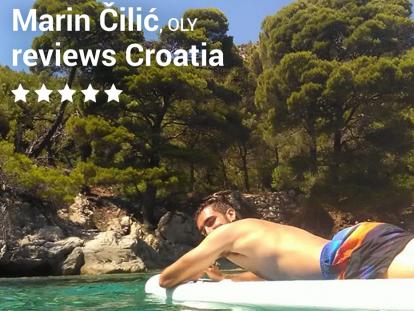
Famous Croatian athletes who chose Croatia for their ideal summer vacation also joined the campaign - Marin Čilić, Domagoj Duvnjak, Darijo Šarić, Sandra Perković, Sinković brothers, Fantela brothers, Ivica Kostelić, Ivan Buljubašić, Dina Levačić, Barbara Matić, Ana Đerek, and more.
For more on travel in Croatia, follow TCN's dedicated page.
Croatian Winter Tourism in 1990: Full of Life! Tour Rep Interview
October 4, 2021 - As the Adriatic coast slowly prepares for its winter hibernation from tourism, some fascinating insights from a UK tour rep in the 1980s, an era when Croatian winter tourism was very much full of life. Could it be again?
There was plenty of lively social media debate in response to the latest TCN editorial this weekend - Could Digital Nomad Concepts Solve Croatian Winter Tourism Problem?
While Croatia has excellent tourism numbers in summer, the Adriatic coast almost shuts down in the winter, with an impact not just on its tourism offer, but also the quality of life of local residents. Recent digital nomad concepts such as Nomad Table - inviting digital nomads to meet and interact over dinner - fills a Split restaurant once a week; a meet-up and pitch night in Zagreb provides entertainment for 50 locals, expats and nomads; and the new Digital Nomad Valley Zagreb co-living concept already has over 50 applications in just 5 days for the winter.
None of these ideas are revolutionary, all are transferrable to mainstream tourism. So is it time to work on a strategic plan for a pilot project on a quality destination such as Split?
Of the many social media reactions, this comment in particular caught my eye.
Both the Amfora and now Riva in Hvar Town were open all winter plus a few restaurants and cafes looking after mainly American tourists for walking, history and the arts. That was up to 1991.
The comment was made by Martin Gannon, a Brit with his heart in Jelsa on Hvar. Martin worked as Operations Manager for Pilgrim Holidays, which was owned by Yugoslav airline JAT from 1986 to 1991. He told me he was busy with tourists 12 months a year covering Dubrovnik, Split, Hvar, Pula, Zagreb, as well as other destinations in former Yugoslavia.
And there were plenty of flights. This, in an era before the low-cost flight revolution. Martin kindly agreed to an email interview to tell us more about winter tourism as it once was.
1. Croatian tourism is very seasonal, with the bulk of tourism in the summer months and almost nothing in the winter months. But it was not always the case. You were Operations Manager for Pilgrim Holidays, owned by Yugoslav airline JAT from 1986-91. Tell us about winter tourism back then.
When I began working for Pilgrim Holidays owned at that time by JAT, we had a large fleet of aircraft. Being a self-management company (a type of workers cooperative similar to Waitrose, John Lewis in the UK) it was not an option to shut down services, or have staff on short-term contracts that they only worked in the summer, so ways were found to keep staff employed and aircraft to still operate. Yes services were reduced compared to the summer, but you could still get direct flights from the UK to Zagreb, Dubrovnik and Split, with connecting services to Pula and Zadar.
My role was to see how to increase the traffic of visitors from the UK to former Yugoslavia.
At the time Yugotours America was successfully bringing tourists from New York on regular DC10 services via Belgrade and Zagreb, staying in Dubrovnik Split and Hvar.
Tourists also came via UK-based operator Saga Holidays on coach tours from Vienna to Dubrovnik. I worked for Saga Holidays from 1980-1983 guiding coach tours of Americans and British tourists who were senior citizens.
With a good number of hotels open, I began developing short winter breaks, better known these days as city breaks, Events tourism in the form of conferences for big companies also took place. Surprisingly for a then Socialist country, religious events such as the St Blaise Festival in February in Dubrovnik, and the developing religious destination Medjugorje, were promoted and visited. At the time JAT had a lot of international flights to India, America, China and Australia, so I organised an option to add a few days. So instead of flying on from London via Zagreb or Belgrade straight on to Sydney, you could stay in Split or Dubrovnik for a few days at a cheap rate.
I also began developing health tourism, spas, dental and even a few skiing and adventure holidays, as well as wildlife spotting, especially in early Spring.
2. This was an era before the low-cost airline revolution. Tell us about the off-season flights to the Croatian coast. Who flew where, and how often?
Flight operations were firstly operated in the tourism off-season by Yugoslav Airlines and Inex- Adria (which became Adria). JAT operated mainly to Zagreb and Belgrade from London and Manchester and Glasgow. There were also flights direct to Ljubljana (for skiing) Dubrovnik and Split, as well as plenty of connecting flights to the coast from Belgrade and Zagreb. Inex- Adria operated from Manchester and Gatwick to Ljubljana and Maribor for skiing Holidays.
The other Airline Aviogenex owned by Yugotours operated from Gatwick to a number of Serbian Airports for skiing Holidays as well as charter services for conferences, mainly to Dubrovnik, where 200-300 delegates would be transported, in support of JAT where we could only supply one aircraft.
3. What was the profile of the winter tourist in Croatia? Which nationalities were the biggest visitors?
The main visitors off-season were Americans, as well as pilgrims for Medjugorje, mostly Irish and Spanish. We also flew in a very large number of Filipinos mainly going to Medjugorje, so we were involved with accommodation and transfers. The Americans were mostly retirees and were interested in history and the arts and food. These would be arranged in groups, and on Hvar Town, the old theatre was used to put performances on in English, from actors from around the then Yugoslavia.
4. Which were the most popular destinations? It is hard to imagine Pula, Split, Dubrovnik and Hvar as 12-month destinations.
The main destinations were Dubrovnik and Split, with add-ons to Pula and Opatija, as well as Plitvice (though this was mainly in Spring). Unfortunately Croatia is not well known for skiing though it has it, so sales were for Slovenia, and the Serbian resort of Kopaonik for skiing holidays, But these could be offered in two-centre holidays which we did a lot of in those days, a week in the mountains skiing then a few days or longer on the coast.
5. Swimming in winter is only for the diehard in Croatia. What did these tourists do on their winter visits?
The hotels used during the winter had indoor pools, and even some had limited spa facilities, so people would enjoy walking, history, and limited sports activities. The majority of these visitors were more senior and would be enjoying the milder coastal conditions. They would not be staying for a week, but up to 6 weeks or longer, as then it was cheaper to stay in a hotel than paying food and heating bills at home, in the UK or US.
You have to remember this was a socialist time so no one could be unemployed. It was better to operate the hotel at a small loss than have staff off, with the hope that the tourists would buy extra drinks, massages etc to cover the extra costs.
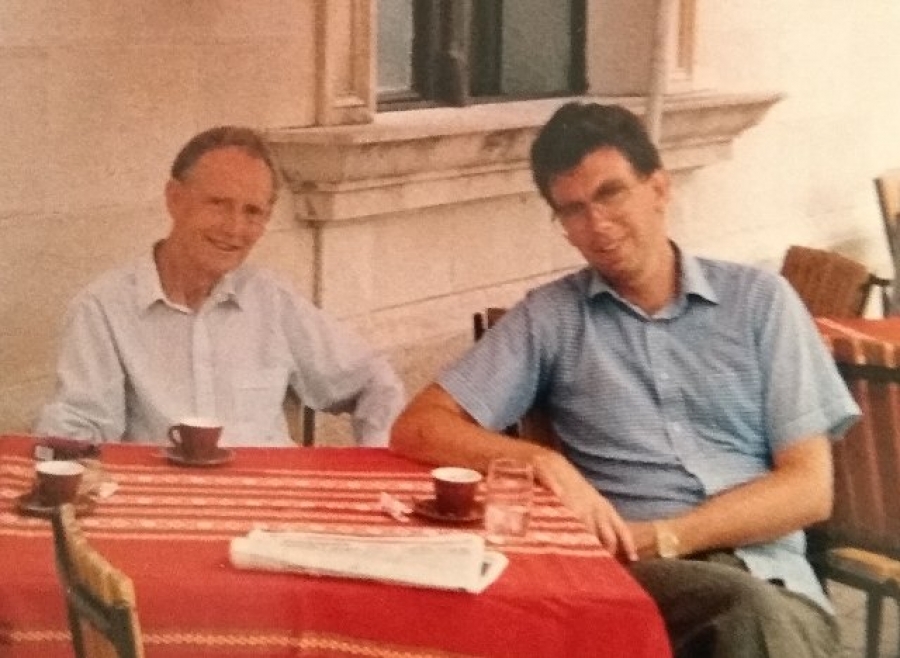
(Martin Gannon, left, taking a coffee break with his father in Jelsa in the 1980s)
6. Let's take Hvar Town as an example. What was open in terms of hotels, restaurants and other tourist facilities?
Hvar Town had the Amfora Hotel open, which had an excellent indoor pool, a medical centre and a specialist health centre for lungs, breathing, and asthma conditions. It also had a sports fitness team, that helped visiting sports teams, such as water polo, football teams in training. And basically anyone who needed advice on sports fitness.
The Slavija Hotel (now Riva) was also open, though mainly for domestic tourism. A few restaurants and cafe bars were open, again most of these were not private, a few were. All museums and theatres were open and fully functioning. Boat excursions of course did not operate in the winter.
7. The Homeland War obviously changed everything. But with such a global boom in tourism 30 years later, why do you think Croatia no longer has the winter tourism it had back in the 1980s? What has changed?
The main reason why Croatia has poor tourism is because of the poor connectivity with flights, but this now has an opportunity to change with Ryanair turning up at Zagreb. But there are still a poor number of domestic flights during the winter. There is also a serious lack of showing the opportunities to visit Croatia off-season, and getting hotels to stay open. And sensible pricing and marketing. It does not need to be a vast number coming, but people who are willing to pay well, and enjoy themselves.
8. We will appoint you as the Croatian Minister of Tourism for this question. Given your experience of tourism back then and the world today, what steps would you take to reintroduce 12-month tourism to Croatia?
Look at marketing Croatia far better, showing its stunning scenery. People now are not looking just for sun and sea; they want something especially in the winter to challenge them, entertain them, enjoy wholesome food and wine and craft beers. These are better to see and visit in the winter than summer when it's almost 40 degrees!!
Many hotels have good sports facilities so get football teams from around Europe over training, as they used to, Water polo teams as well. A popular sport now is cold water swimming, loads of exciting rivers in Croatia to try this challenge. Yoga holidays healthy food, spas, medical tourism especially dental work, and yes, skiing outside of Zagreb.
Maybe not so much now post-Covid but stlll companies will have conferences, so give them good deals, the delegates will come back themselves with their families when they see how stunning Croatia is. I know this as a fact as I used to rebook delegates onto our summer holidays when at Pilgrim.
Nature tours, environmental trips travelling around by train. Working holidays, helping plant trees in burnt areas. Projects to help rebuild areas damaged by earthquakes, some of these ideas will be for small groups but they are high-value tourists and most importantly will visit again and also tweet, and snapshot what they are up to, getting free publicity.
Interesting stuff, thanks Martin. If anyone else has memories or a contribution of Croatian winter tourism as it once was, then please contact us at This email address is being protected from spambots. You need JavaScript enabled to view it. Subject Winter Tourism.
Martin has contributed to TCN before with a really interesting account of tourism restarting after the Homeland War, a different era. Read more in Restarting Croatian Tourism from the UK After the Homeland War: a Travel Agent's Tale.
So Long, Ferragosto! More Italians in Croatia in September Than August
October the 4th, 2021 - Ferragosto is typically ''celebrated'' by Italians in Croatia during the blisteringly hot month of August, and whether or not the coronavirus pandemic has changed this habit, or something else has altered, there were more Italians in Croatia in September this year.
As Novac/Jutarnji/Barbara Ban writes, the Croatian travel company Croatia Luxury Rent recorded an increase the arrivals of Italians in Croatia during the month of September. This is an increase of three percent when compared to August, which they say was one of the most successful months for Croatian tourism in the last few seasons. A turn of events few expected back in spring.
''The causes of such sales results should be sought in more economic and sociological details. First of all, it should be noted that due to economic circumstances, Croatia as a destination has become too expensive for Italians to visit to some extent. That's why they're looking for arrangements outside the prime part of the tourist season, when they are more favourable. Furthermore, Italy is extremely sensitive to the effects of coronavirus due to high mortality in their country at the very beginning of the global pandemic, so the reason for their later arrival in slightly larger numbers on the Adriatic is probably the fact that due to fewer tourists in destinations, there is no greater threat of infection,'' they explained from CLR.
There are very few retirees...
They also presented information on the types of Italians in Croatia this summer, and there were very few retirees to speak of.
''Demographically speaking, the largest percentage of Italians in Croatia since the beginning of the summer season were families with children and travellers of younger age groups, who were looking for isolated accommodation in destinations not far from the most popular tourist centres. There's been a slightly lower percentage of Italian guests of the older age group,'' CLR claims.
Istria and Kvarner
They are also satisfied with this, a small shift, because in the last few years, Italians have been choosing Croatia less and less for their summer holidays.
''As the number of arrivals of guests from this market has been systematically decreasing over more recent seasons, such sales results are in a way, quite the surprise. The Italians who visited Croatia in September chose Istria and Kvarner once again, of which the most sought after destinations were Porec, Rovinj, Umag, Crikvenica and Opatija,'' they concluded.
For more, make sure to check out our dedicated travel section.


